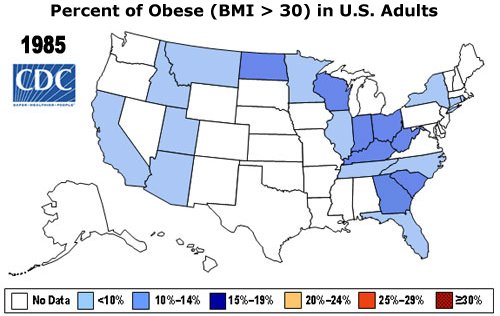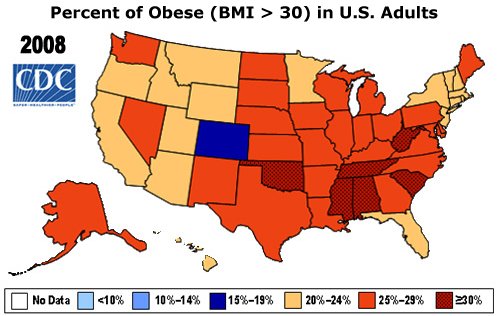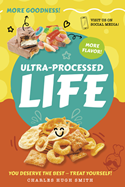This Nation's Devolution from Quality to Convenience
In the trade-off between quality and convenience, Americans now expect convenience in everything but healthcare, with disastrous long-term results. Fellow AOL blogger Kevin Maney has written a very insightful and interesting business/marketing book, Trade-Off: Why Some Things Catch On, and Others Don't. In 22 years reporting on technology and business for USA Today, Maney discerned a key mechanism at work in the consumer goods and services markets: consumers face a fundamental trade-off between quality (what Maney calls "fidelity") and convenience. Maney suggests that it is essentially impossible to dominate markets by providing both fidelity/quality and convenience, and that companies which prosper do so by excelling in one or the other. By "fidelity" he means the customer experience, the aura (coolness factor) and what the product/service adds to the customer in identity/social value. For example, Apple products have been a sign of coolness/creativity since 1985 (with a brief spot of bother in the 1995-98 period before Steve Jobs returned to whip the company back into shape). High Fidelity explains why people willingly plunk down $125 a ticket for a live concert even as they spurn a $15 CD by the same artist: the concert experience is unique and high value (presumably) while the CD music can be downloaded for free (very convenient). Wal-Mart gained ubiquity by being convenient: consumers can buy a wide variety of stuff in one place for low prices--a feature Maney considers "convenient" because you can buy more stuff if the costs are low. It seems to me this trade-off can be extended far beyond consumer goods and services, and thus could help explain why the U.S. culture and economy are devolving so rapidly. Frozen pizzas, microwave cuisine and fast-food are all very convenient and moderate in cost; preparing real food is also moderate in cost but it is not convenient/quick, though it is high quality. (Please don't tell me fast-food is "cheap"; a burger, fries and soft drink meal in a California Burger King takes most of a $10 bill. I can buy an entire grocery bag of real food in Chinatown for $14--less than two fast-food meals.) U.S. for-profit healthcare is costly and high-quality (on a global continuum of care) but not convenient (long waits, denial of coverage, arcane, voluminous paperwork, etc.). Are these related? Yes, in the sense of being the highest-profit models possible. The profit margins on broccoli and carrots is near-zero, but the profit margins on greasy fries is stupendous--ditto heavily salted/sugared/fat-soaked microwave "food." Convenience is the marketing weapon deployed to sell unhealthy food, while "quality" is the pitch deployed to sell insanely overpriced medical care. Which strangely enough, is required after a lifetime of eating unhealthy food. Low-cost public health measures which would have a highly leveraged positive effect on Americans' health and well-being are eschewed or underfunded because there's simply no profit in incentivizing people to eat better, schedule basic checkups, learn routines to improve their fitness and mental health, etc. By hiding the true costs of healthcare behind employer insurance and/or Medicare/Medicaid, then consumers treat healthcare as if it was "free." If it's "free," then why not demand the very best? And if the government will pay whatever I bill it, then why not provide "the very best"? If there is no "cost" to living unhealthily (but with high convenience), then why not live conveniently and then demand the government provide quality healthcare? Except of course the incentives are all perverse, and the entire system is spiraling rapidly toward inevitable insolvency. We can't place the blame entirely on fast-food or indeed any specific factor, as fast-food was already ubiquitous in 1985, as were TV dinners, etc. Yet the explosion of obesity and related diseases has all occurred in the past 23 years since 1985: The obesity epidemic can be viewed visually via this slideshow map of the U.S.: Centers for Disease Control, U.S. Obesity Trends 1985-2007 It seems reasonable to suggest that larger cultural forces are at work in this catastrophic decline in American well-being and health, not just the availability of junk food. Learning is a quality experience, but difficult and not convenient, that is, it can't be done while texting and watching TV, etc. It exacts a heavy toll in time and concentration. Can we trace the degradation of American academic performance to a cultural preference for convenience over quality? My lazy American students (Boston Globe) I mentioned this article to an Asian female friend (wife of one of our friends) who'd earned a graduate degree (M.A.) at an exclusive private university in the U.S., and she nodded in recognition. She said she'd been very intimidated by the American students during her first semester, as they seemed so poised and articulate in class. Yet when the semester came to a close, the big talkers didn't turn in their final papers. In effect, they'd just BS'ed their way through class but had done none of the real work of learning. They were masters of BS and excuses, not real learning/work. That may well be a metaphor for U.S. education as a whole. Is it somehow the teachers' fault that many U.S. students have become lazy BS Artists? Learning is inconvenient, and by the Consumerist Values now implanted in the culture, this is wrong; learning should be convenient and high-quality--like buying a Starbucks latte. Fixing things in the real world is also difficult and inconvenient, so Americans have also lost interest in learning how to repair physical mechanisms in the real world. Survey finds more in U.S. avoid hands-on projects or repairs: "Many Americans simply do not work with their hands anymore, whether it's to tackle a hobby for pleasure or to handle a necessary household repair. Young people essentially have no role models when it comes to fixing things or taking pride in building something," said Gerald Shankel, Fabricators and Manufacturers Association president. The Hudson Institute, a public policy think tank in Washington, D.C., predicts the supply of skilled labor in the U.S. will not catch up with the demand until the year 2050. Many studies predict a labor shortage as waves of blue-collar workers reach retirement age. A national poll of 500 teenagers, however, showed that 73% had little or no interest in those hands-on careers. While this is an admittedly small sample, I have over the years provided other data which supports the same thesis: few young Americans have demonstrable interest in learning high-quality, difficult real-world trades and craft skills, perferring, it seems, the fantasy that some app will make them rich in a convenient fashion (hole up with a few friends for a weekend, cobble together the coding, upload the product and bang, instant wealth via a media/Facebook application/product.) Apparently the incentives are no longer in place for quality to be rewarded; convenience is rewarded everywhere except government and healthcare (and since government already dictates most of what goes on in healthcare via Medicare and other programs, then they are closely bound). How many American consumers demand to buy an American-made wrench which costs $25 and lasts generations when a $10 knockoff which rusts and breaks in a few years is available at Wal-Mart (or elsewhere)? No demand, no supply. It's not convenient to maintain tools and plan on passing them on to your grandkids; it's convenient to buy a low-quality tool and then throw it out a few years (or days) later, or leave it rusting in the garage until you move, or just call a handyman and never buy the tool at all. It really is inconvenient to do anything in the real world, so why should we bother? It's also inconvenient to buy and prepare real food, even if it is high-quality and much better tasting. And fitness? Don't get us started! It's horribly inconvenient to maintain some modest level of fitness; we might even sweat (ugh) or feel some sort of minor temporary discomfort (which is always inconvenient--give me a drug, quick!) Here is the Army Physical Fitness Test, which lists three basic tests for strength and endurance: situps, pushups and a 2-mile run, broken down into age and male/female categories. You must score at least a 50 in each event in order to graduate Basic Combat Training. Active Duty soldiers need to score at least 60 to pass the APFT. NOTE: do not attempt the tests if you are out of shape, in poor health, etc. Just to see how I'd do, I did my usual stretching this morning and then did as many pushups as I could easily manage in a minute or so. (The test allows 2 minutes but I was determined not to push myself.) I did 35 pushups, which gave me a score of 61, meaning I was fit for active duty in the U.S. Army as a 37 to 41-year old male (I am 56 years old). (The minimum score is 60.) A 37 to 41-year old active-duty female is expected to do 13 pushups. I did 40 situps in a little over a minute (with nobody holding my feet, so this was more difficult), which gave me a score of 62, above the minimum score required of active-duty males 37-41 (minimum score is 60). A 37 to 41-year old active-duty female is also expected to do 38 situps in 2 minutes. I did not do the 2-mile run today, but the time required for 37-41 year old active duty males is 18:18 (18 minutes and 18 seconds). Since my usual jog is two kilometers in 10 minutes, and 3.2 KM = 2 miles, I would expect my time to be under 18 minutes. A 37 to 41-year old active-duty female is expected to cover 2 miles in 22:42 or less. (Brisk walking pace is 3 miles per hour or 20 minutes per mile.) I don't go to the gym every day (or ever, actually), and while I do bicycle and walk and jog a bit here and there (perhaps once a week, just for the fun of it), go swimming in the sea when I'm in Hawaii, and do martial arts for two hours a week, I consider myself moderately fit at best--especially when you think of the guys and gals who toil up the Himalayas in Nepal, toting Western tourists' gear and goodies. In other words, I am not in training for the senior Olympics or the half-marathon; I am moderately active in the way many people are active around the world. Serious athletes in my age group would blow me out of the water in all these categories of fitness. I work 12-hour days just to keep up this blog, do my other writing jobs and make a living on the side. I don't have time to be a serious athlete, and I am overly fond of chocolate as well (my willpower melts like, well, chocolate). In fact, when I wanted to be a good athlete, in middle school and high school, stupendous efforts on my part yielded mediocre results in three sports: football, track and basketball. So I don't have any genetic propensity toward large lung capacity, great strength or endurance, etc. Yet I rather easily met the fitness qualifications for active-duty Army personnel (males) 15 years my junior. This suggests to me not that I am super-fit but the standards are rather low. And I suspect the Army standards are considered "rigorous" and "tough" in the broader culture, if not "nearly impossible" for those over 55. It isn't convenient to be even moderately fit, it seems; and so perhaps the American response is to lower the standards for everything relentlessly, so that nothing gets too inconvenient. But then it's never high quality, either. You can't have it both ways. Order Survival+: Structuring Prosperity for Yourself and the Nation from your local bookseller or from amazon.com or in ebook and Kindle formats. A 20% discount is available from the publisher. Expanded free eBook now available (85,300 words, 136 pages): NOTE: the Kindle reader for PCs is now available for free which means you canread the Kindle version of Survival+ on your PC. 

The United States has become a nation of "non-tinkerers," a new survey shows, and it has harmed the way we live and work.
NOTE ON THE SURVIVAL+ BOOK: I am reformatting the interior for improved readability, so your order will not ship for a few days. Your patience will be rewarded with a new cover and more readable text.
in HTML: Survival+ in PDF: Survival+
Of Two Minds is now available via Kindle: Of Two Minds blog-Kindle
Thank you, James W. ($200), for your staggeringly generous contribution to this site. I am greatly honored by your support and readership. Thank you, Bram S. ($50), for your exceedingly generous contribution to this site. I am greatly honored by your support and readership.


























